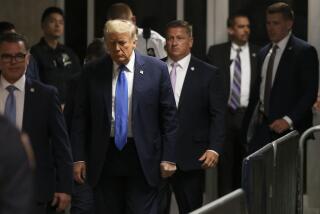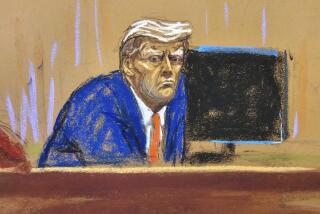U.S. Appeals Court May Permit Camera Coverage : Judiciary: Group of jurists propose allowing television in their courtrooms. Plan deals with the appellate circuits only, not trial level.
WASHINGTON — Cameras could be allowed in federal appeals courts starting next year under a proposal by a group of judges that comes not long after a judicial panel refused to open federal courtrooms to such coverage.
“If we’re going to do it, we’ve got to be very careful about it,” Chief Judge Gilbert S. Merritt of the Cincinnati-based U.S. 6th Circuit Court of Appeals, who supports the new proposal, said Friday.
In appellate courts, lawyers argue before a panel of judges and there are no witnesses or jurors. Thus, appellate judges need not worry--as some trial judges do--that jurors or witnesses might be intimidated by the prospect of winding up on the evening news, Merritt said.
“The only benefit of cameras in the courts is so that the American people are informed as to what goes on in the courtrooms,” Merritt said. “Anything that is done with cameras that doesn’t carry out the function is beside the point.”
Most of the chief judges of the 13 federal appeals circuits have signed a letter asking a committee of the U.S. Judicial Conference to recommend allowing cameras into the appeals courts, Merritt said. The 27-member conference is the federal judiciary’s policy-making body and is chaired by Chief Justice William H. Rehnquist.
Each appellate circuit might be allowed to decide for itself whether to allow cameras in the courtrooms, Merritt said. If the committee approves in December, the conference could vote on the proposal in March, he added.
The Judicial Conference committee also is expected next month to consider a new experiment to allow television and still cameras into federal trial courts.
A 3 1/2-year experiment that allowed cameras into civil trials in six federal district courts and two appeals courts will expire at the end of the year. Even though a study on the experiment found only “small or no effects” from the experiment, the Judicial Conference voted in September by a 2-1 margin not to open federal courts across the country to camera coverage.
The proposed new experiments are aimed at heading off the broadcast media’s tendency to use short “sound bites” of trial coverage, Merritt said.
“The camera can be used to mislead as well as to inform if it’s not in context,” he said.
The judge said one proposal would require any camera coverage to continue for the duration of the trial, although the news organization would not be required to broadcast all of the material.
Another proposal, he said, would set a minimum length--something more than 15 seconds--for any video excerpt that is broadcast.
Merritt said the conference’s September vote focused mainly on the effects of cameras in trial courts.
The appellate judges’ new proposal seeks to make a distinction between cameras in appellate courts and trial courts “and to indicate that there’s more support for one than the other,” Merritt said.
The experiment that ends next month has been conducted in federal trial courts in Indiana, Massachusetts, Michigan, New York, Pennsylvania and Washington and federal appeals courts in New York and San Francisco.
Every state except Indiana, Mississippi and South Dakota allows some use of cameras in state trial or appeals courts.
More to Read
Get the L.A. Times Politics newsletter
Deeply reported insights into legislation, politics and policy from Sacramento, Washington and beyond. In your inbox three times per week.
You may occasionally receive promotional content from the Los Angeles Times.










